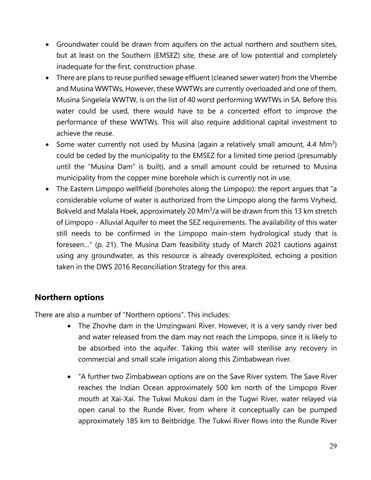•
Groundwater could be drawn from aquifers on the actual northern and southern sites, but at least on the Southern (EMSEZ) site, these are of low potential and completely inadequate for the first, construction phase.
•
There are plans to reuse purified sewage effluent (cleaned sewer water) from the Vhembe and Musina WWTWs, However, these WWTWs are currently overloaded and one of them, Musina Singelela WWTW, is on the list of 40 worst performing WWTWs in SA. Before this water could be used, there would have to be a concerted effort to improve the performance of these WWTWs. This will also require additional capital investment to achieve the reuse.
•
Some water currently not used by Musina (again a relatively small amount, 4.4 Mm3) could be ceded by the municipality to the EMSEZ for a limited time period (presumably until the “Musina Dam” is built), and a small amount could be returned to Musina municipality from the copper mine borehole which is currently not in use.
•
The Eastern Limpopo wellfield (boreholes along the Limpopo): the report argues that “a considerable volume of water is authorized from the Limpopo along the farms Vryheid, Bokveld and Malala Hoek, approximately 20 Mm3/a will be drawn from this 13 km stretch of Limpopo - Alluvial Aquifer to meet the SEZ requirements. The availability of this water still needs to be confirmed in the Limpopo main-stem hydrological study that is foreseen…” (p. 21). The Musina Dam feasibility study of March 2021 cautions against using any groundwater, as this resource is already overexploited, echoing a position taken in the DWS 2016 Reconciliation Strategy for this area.
Northern options There are also a number of “Northern options”. This includes: •
The Zhovhe dam in the Umzingwani River. However, it is a very sandy river bed and water released from the dam may not reach the Limpopo, since it is likely to be absorbed into the aquifer. Taking this water will sterilise any recovery in commercial and small scale irrigation along this Zimbabwean river.
•
“A further two Zimbabwean options are on the Save River system. The Save River reaches the Indian Ocean approximately 500 km north of the Limpopo River mouth at Xai-Xai. The Tukwi Mukosi dam in the Tugwi River, water relayed via open canal to the Runde River, from where it conceptually can be pumped approximately 185 km to Beitbridge. The Tukwi River flows into the Runde River 29





